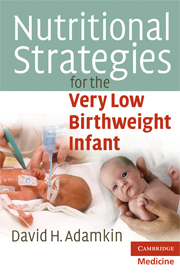33 results
4 - Intravenous carbohydrates
-
- Book:
- Nutritional Strategies for the Very Low Birthweight Infant
- Published online:
- 05 August 2012
- Print publication:
- 27 August 2009, pp 23-28
-
- Chapter
- Export citation
24 - Nutritional assessment
-
- Book:
- Nutritional Strategies for the Very Low Birthweight Infant
- Published online:
- 05 August 2012
- Print publication:
- 27 August 2009, pp 143-152
-
- Chapter
- Export citation
16 - Premature infant formulas
-
- Book:
- Nutritional Strategies for the Very Low Birthweight Infant
- Published online:
- 05 August 2012
- Print publication:
- 27 August 2009, pp 117-122
-
- Chapter
- Export citation
2 - Fluid and electrolyte management (Na, Cl and K)
-
- Book:
- Nutritional Strategies for the Very Low Birthweight Infant
- Published online:
- 05 August 2012
- Print publication:
- 27 August 2009, pp 9-16
-
- Chapter
- Export citation
26 - Nutritional management of preterm infants with short bowel syndrome
-
- Book:
- Nutritional Strategies for the Very Low Birthweight Infant
- Published online:
- 05 August 2012
- Print publication:
- 27 August 2009, pp 163-174
-
- Chapter
- Export citation
21 - Iron
-
- Book:
- Nutritional Strategies for the Very Low Birthweight Infant
- Published online:
- 05 August 2012
- Print publication:
- 27 August 2009, pp 135-136
-
- Chapter
- Export citation
14 - Optimizing enteral nutrition: protein
-
- Book:
- Nutritional Strategies for the Very Low Birthweight Infant
- Published online:
- 05 August 2012
- Print publication:
- 27 August 2009, pp 101-110
-
- Chapter
- Export citation
6 - Early total parenteral nutrition (TPN)
-
- Book:
- Nutritional Strategies for the Very Low Birthweight Infant
- Published online:
- 05 August 2012
- Print publication:
- 27 August 2009, pp 37-44
-
- Chapter
- Export citation
15 - Human milk
-
- Book:
- Nutritional Strategies for the Very Low Birthweight Infant
- Published online:
- 05 August 2012
- Print publication:
- 27 August 2009, pp 111-116
-
- Chapter
- Export citation

Nutritional Strategies for the Very Low Birthweight Infant
-
- Published online:
- 05 August 2012
- Print publication:
- 27 August 2009
19 - Protein hydrolysate formulas
-
- Book:
- Nutritional Strategies for the Very Low Birthweight Infant
- Published online:
- 05 August 2012
- Print publication:
- 27 August 2009, pp 127-130
-
- Chapter
- Export citation
Contents
-
- Book:
- Nutritional Strategies for the Very Low Birthweight Infant
- Published online:
- 05 August 2012
- Print publication:
- 27 August 2009, pp vii-viii
-
- Chapter
- Export citation
5 - Intravenous lipids
-
- Book:
- Nutritional Strategies for the Very Low Birthweight Infant
- Published online:
- 05 August 2012
- Print publication:
- 27 August 2009, pp 29-36
-
- Chapter
- Export citation
1 - Introduction
-
- Book:
- Nutritional Strategies for the Very Low Birthweight Infant
- Published online:
- 05 August 2012
- Print publication:
- 27 August 2009, pp 1-8
-
- Chapter
- Export citation
Index
-
- Book:
- Nutritional Strategies for the Very Low Birthweight Infant
- Published online:
- 05 August 2012
- Print publication:
- 27 August 2009, pp 183-191
-
- Chapter
- Export citation
12 - Enteral nutrition
-
- Book:
- Nutritional Strategies for the Very Low Birthweight Infant
- Published online:
- 05 August 2012
- Print publication:
- 27 August 2009, pp 79-88
-
- Chapter
- Export citation
13 - Enteral feeding guidelines practicum
-
- Book:
- Nutritional Strategies for the Very Low Birthweight Infant
- Published online:
- 05 August 2012
- Print publication:
- 27 August 2009, pp 89-100
-
- Chapter
- Export citation
11 - Parenteral nutrition-associated cholestasis in VLBW infants
-
- Book:
- Nutritional Strategies for the Very Low Birthweight Infant
- Published online:
- 05 August 2012
- Print publication:
- 27 August 2009, pp 69-78
-
- Chapter
- Export citation
20 - Enteral calcium, phosphorus, magnesium, and vitamin D
-
- Book:
- Nutritional Strategies for the Very Low Birthweight Infant
- Published online:
- 05 August 2012
- Print publication:
- 27 August 2009, pp 131-134
-
- Chapter
- Export citation
7 - Parenteral calcium, phosphorus, magnesium, and vitamin D
-
- Book:
- Nutritional Strategies for the Very Low Birthweight Infant
- Published online:
- 05 August 2012
- Print publication:
- 27 August 2009, pp 45-50
-
- Chapter
- Export citation



